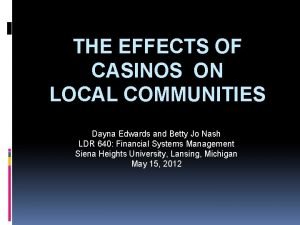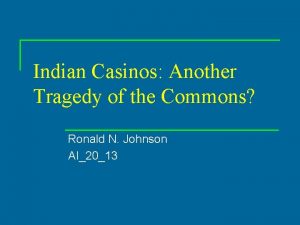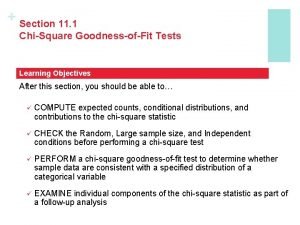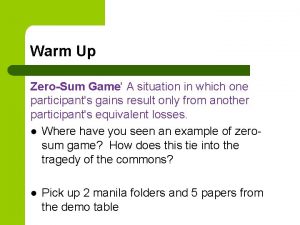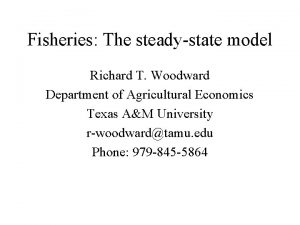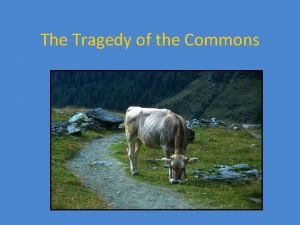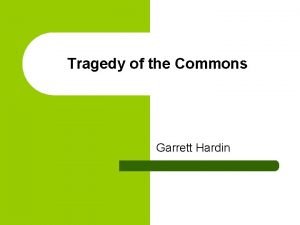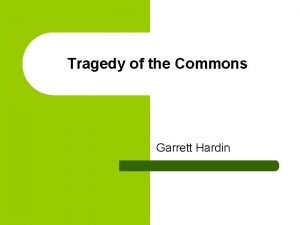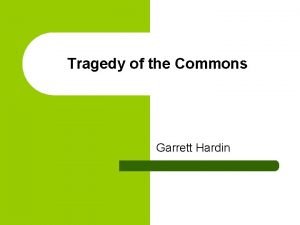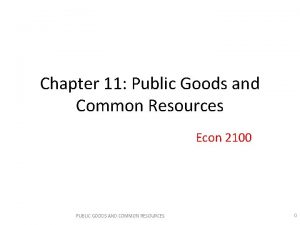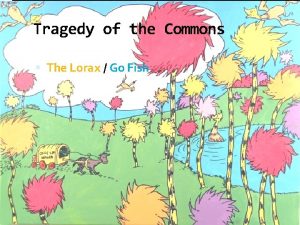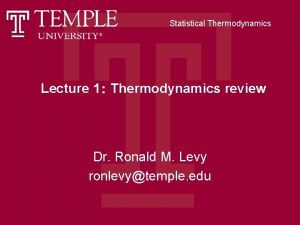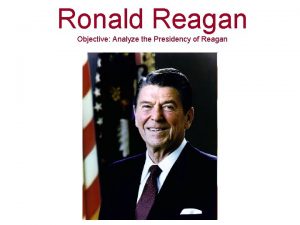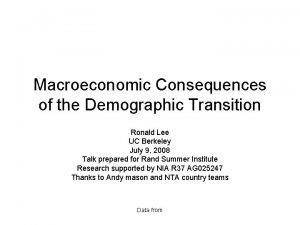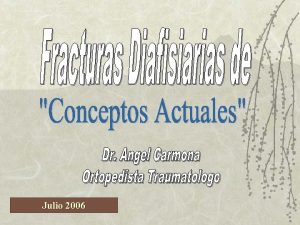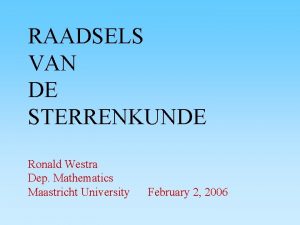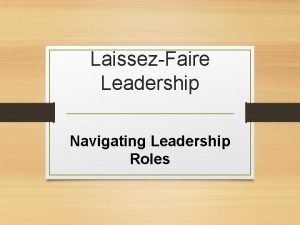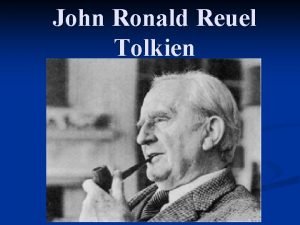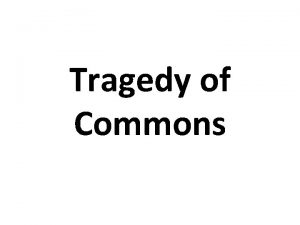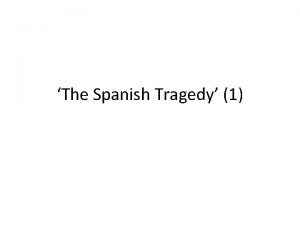Indian Casinos Another Tragedy of the Commons Ronald






























































- Slides: 62

Indian Casinos: Another Tragedy of the Commons? Ronald N. Johnson AI_20_13

Abstract n n Indian Gaming Regulatory Act of 1988 The rapid growth of Indian casinos has surprised many and the revenues generated, $16. 7 billion in 2003, are staggering. But, property rights have not been clearly delineated. The Indian Gaming Regulatory Act requires states to negotiate in “good faith” with tribes seeking to develop Las Vegas-style casinos. 2

Abstract n The result has been the socially costly pursuit of wealth transfers as state and local governments have come to realize the enormity of the funds generated by Indian casinos. n Tribes have now become major contributors to political campaigns. 3

I. Introduction n Casino gaming, however, has brought a new source of wealth to a number of formerly impoverished Indian tribes. n A key factor contributing to the success of Indian gaming is the sovereign status enjoyed by Indian tribes. 4

Sovereignty n The sovereign status of Indian tribes and the special nature of their relationship to both federal and state governments was recognized in the well known cases of Cherokee Nation v. Georgia, 30 U. S. 1 (1831) and Worcester v. Georgia, 31 U. S. 515 (1832). 5

Growth Industry n Backed initially by a series of court decisions, Indian tribes have leveraged their sovereign status to participate in this growth industry, legalized gambling. 6

State Opposition n n But, many states opposed Indian gaming. q The result was passage of the Indian Gaming Regulatory Act of 1988 (IGRA). A tribe must negotiate a compact agreement with the state where the casino is to be located. q In essence, regulatory jurisdiction over Indian-operated, Las Vegas-style casinos would involve three sovereigns: the federal government, the state in which a tribe has land, and the tribe itself. 7

Too Many Claimants n From a property rights perspective, the Act allows for too many claimants, a situation that encourages the socially costly pursuit of gaming profits, a type of activity often referred to as “rent seeking. ” 8

Under-Usage? n Reducing the number of sovereigns to one would reduce the potential for conflict over resource development and rent seeking. 9

Reducing the Net Returns n The recent and largely unanticipated success of Indian gaming has prompted state politicians to seek revenue sharing and other concessions from gaming tribes. q In response, gaming tribes have become major contributors to political campaigns. 10

II. The Rise of Indian Gaming n During the 1980 s, both the Reagan and Bush administrations reaffirmed the policy of selfdetermination, even if it included gaming operations. q The idea was to encourage tribes to develop their own enterprises, while also lowering federal expenditures on Indian programs. 11

First Step to Indian Gaming: The Crack in the Dike n n n In 1979, the Seminole Indians opened a relatively high stakes bingo operation that became an instant success. The federal circuit court ruled that Florida could not assert its jurisdiction over the Seminoles’ bingo operations. In essence, the court reinforced a “regulatory” versus a “prohibitory” distinction that became critical in a series of later cases. 12

The Resulting Flood n By 1987, over 100 tribal bingo facilities, grossing close to $200 million, were in operation. n Moreover, by the mid-1980 s tribes were seeking to expand their gaming activities to include card games. q This expansion produced another state challenge to tribal gaming. 13

States Seek Help from Congress n n Federal court rulings, starting with the Seminole case, were generally favorable to Indian gaming. So states took their concerns about the harmful effects of Indian gaming to Congress. Naturally, the states were joined in their opposition to Indian gaming by casino operators in Las Vegas and New Jersey. Congress enacted the IGRA--clearly a compromise —but it gave the states more influence over Indian gaming than the courts had given them. 14

IGRA n n The IGRA divided gaming into three classes, each class subject to differing degrees of tribal, state, and federal jurisdiction and regulation. The definition of class III gaming is broad. q Games commonly played at Las Vegas-style casinos, such as slot machines, black jack, craps, and roulette, would clearly fall in the Class III category. 15

16

Tribe-State Negotiations n n n Before a tribe may lawfully conduct Class III gaming, the following conditions must be met: (1) The particular form of gaming that the tribe wants to conduct must be permitted in the state in which the tribe is located; and (2) The tribe and the state must have negotiated a compact that has been approved by the Secretary of the Interior. q States required to negotiate in “Good Faith” 17

Property Rights and Wealth n n n A sovereign with the ability to protect the property of the citizens from outside forces while itself refraining from excessive confiscation would encourage the expansion of aggregate wealth. But, modern governments, especially democratic ones, do not have clearly defined residual claimants, a situation that can lead to excessive demands by competing parties and a failure to develop the resource: a tragedy of the anti-commons. Despite the potential for conflict inherent in the IGRA, however, Indian gaming has been a growth industry. 18

III. The Revenues at Stake n Data on Indian gaming net revenues, sometimes referred to as net win (dollars wagered minus payouts), shown in Table 1 indicates a very rapid rise in revenues, especially in the years immediately following passage of the IGRA. 19

20

Revenue Growth has Declined n The $16. 7 billion garnered by gaming tribes in 2003 accounts for about 23 percent of total legal gaming revenues in the U. S. n The future rate of growth of Indian gaming will be more constrained by the overall rate of growth in the demand for gaming than it has been in the past. 21

Revenues are Concentrated n Although Indian gaming revenues are impressive, amounting to about $8, 500 per enrolled tribal member in 2002, revenues are concentrated. n According to the National Indian Gaming Commission, 64 percent of gaming revenues were earned by 13 percent of the 330 Indian gaming establishments in 2003. 22

23

Remoteness? n Many of the tribes that have chosen not to participate are located in remote sections of the country, distant from major population centers. n Of course, Las Vegas wasn’t considered to be in close proximity to anything when it first opened casinos. 24

IV. Carving up the Pie: The External Threats n n As states began to realize the potential for added revenues, politicians were also beginning to see another potential, the willingness of gaming tribes to make large campaign contributions to establish and maintain Class III gaming operations. The traditional concept of rent seeking stresses that lobbying and litigation expenditures could equal potential profits resulting in the complete dissipation of rents. 25

Political Extortion of Rents n State politicians have used a variety of threats, including the threat of expanding gaming to non. Indians in order to obtain concessions from gaming tribes. 26

Limiting State Political Power n By granting the states a degree of veto power over Class III operations, the IGRA essentially gave the states and/or their politicians the right to claim part of the residual. n Compacts must be approved by the Secretary of the Interior, and the department has made clear that attempts to extract excessive amounts from the tribes would be met with a denial of the compact. 27

Compacts to Allow Indian Gaming n To preserve rents, both politicians and gaming tribes have an incentive to restrict entry. n The key to achieving a compact agreement in a number of important cases has been a tribe’s willingness to share gaming revenues with the state. 28

Revenue Sharing and Entry Restrictions n n To date, the Secretary of the Interior has approved compacts with revenue-sharing provisions in six states. Importantly, should the state renege on the exclusivity agreement, revenue-sharing payments from tribes cease. q Indeed, Michigan tribes stopped making payments when the voters in Michigan authorized three non. Indian casinos in Detroit. 29

The Pequots’ Offer n n n Governor of Connecticut had declared he was adamantly against allowing slots. The Pequots offered the state one hundred million dollars a year or 25 percent of the winnings, whichever was greater, if the tribe were granted the exclusive rights to operate slot machines in the state. It was an offer that was difficult to refuse, especially since the state was running a large deficit at the time and there was public support for Indian gaming. 30

31

32

Connecticut Captures Rents n n n Today, the Pequots operate one of the world’s largest casino, and Foxwoods’ revenue-sharing contribution to the state of Connecticut in fiscal 2004 was $197 million. The Mohegan Tribe, which operates the Mohegan Sun Casino (1996), paid $206 million to the state over the same period. The total of $403 million far exceeds Indian revenue sharing in any of the other states. 33

34

California n n When the IGRA passed in 1988, California had a state lottery and allowed wagering on horse races, bingo for charitable purposes, and non-banked card games. Accordingly, tribes were essentially free to establish Class II gaming operations, but would have to induce the state to sign compact agreements and, eventually, amend the state constitution before they could legally engage in Las Vegas-style gaming operations. 35

Proposition 5 n n n If passed, Proposition 5 would permit tribes to offer certain electronic gambling devices. Importantly, this type of gaming could only occur on Indian lands, essentially granting gaming tribes exclusive rights to slot machines in California. In November of 1998 voters overwhelmingly approved Proposition 5, with 62. 4 percent of the vote. q The voters had a clear sense that reparation was in order, and that this was a way to accomplish it. 36

The perfect alternative to Las Vegas 37

Proposition 1 A n n In August 1999, however, the Prop 5 was ruled unconstitutional by the California State Supreme Court. Anticipating passage of Prop 1 A, Governor Gray Davis quickly signed compact agreements with 57 tribes. On March 7, 2000, the voters of California approved proposition 1 A by a margin of 64 percent. The state constitution was amended to allow slot machines on federally recognized tribal lands 38

Mutually Beneficial n n The amendment essentially granted tribes exclusive rights to operate slot machines in the state. The compact agreements state, “In consideration for the exclusive rights enjoyed by the tribes, and in further consideration for the State’s willingness to enter into this Compact, the tribes have agreed to provide the state, on a sovereign-tosovereign basis, a portion of its revenue from Gaming Devices. ” 39

Arnold’s Renegotiation n n Indian gaming revenues in California were approximately $4. 7 billion in FY 2003 and are growing rapidly. This new-found wealth, coupled with a large state budget deficit, prompted newly elected Governor Arnold Schwarzenegger to seek additional revenues from the tribes. q New compacts would provide an additional $100 million annually to finance a $1 billion bond for the state and could generate up to $200 million a year in recurring revenue from additional slots permitted under the new compacts. 40

New York n n n In New York, only one tribe, the Seneca, currently has a revenue sharing compact. In exchange for sharing up to 25 percent of the revenue with the State, the compact grants the tribe exclusive rights to open three casinos in western New York (see Table 2). The tribe has one off-reservation casino in Niagara Falls and plans another off-reservation casino in suburban Buffalo. 41

Competition? n Competing head to head with non-Indian gaming establishments in some states, e. g. , Nevada and Montana, does not appear to have been a particularly fruitful endeavor. n On the other hand, gaming tribes have more than held their own in states like Michigan and Mississippi that allow Las Vegas-style non-Indian casinos but restrict their locations. 42

Limits to State “Extortion” n n n Tribes negotiating the amount of revenue sharing and the degree of exclusivity have a fallback position that limits the amount states can extract. Accordingly, the percent of revenues tribes share with the states should be relatively small compared to the revenues extracted from non-Indian casinos. Table 3 reveals considerable variation in gaming revenue tax rates imposed on non-Indian land riverboat casinos in the eleven states that allow Las Vegas-style casinos. 43

44

45

Tribes Avoid High Rates n n The average tax rate across the eleven states with major casino operations is 16 percent, a figure that is high compared to most of the rates shown in Table 2. Thus, the evidence suggests that even though gaming tribes with revenue sharing compacts have been targeted by states as a revenue source, most have managed to avoid the higher rates paid by many non-Indian casino operators. 46

Federal Campaigns n n n During the 2002 election cycle, the casino industry contributed over $14 million to federal office seekers, ranking 27 th among all industry groups, up from 75 th in the 1990 election cycle. As the Pequot tribe demonstrated early on, gaming tribes have access to sufficient funds to make them a potent interest group. During the 1990 election cycle, gaming tribes contributed only $1, 750, but in the 2002 election cycle they contributed over $6. 6 million, or 47 percent of the industry total. 47

State Contributions n n n The terms of the IGRA, make clear that most of the obstacles to Indian gaming are at the state level. Hence, one should expect campaign contributions at the state level to be even higher than they are at the federal level. Indeed, since 1998, tribes in California alone have contributed well over $100 million to candidates and initiative campaigns, making them one of the largest contributors in the state. 48

Political Costs are Relatively Low n n n A conservative estimate puts net gaming revenue to tribes at $3. 7 billion. Total tribal government contributions to candidates and state ballot initiatives in the 2002 election cycle was $41. 5 million. Although in some states individual tribes may rank in the top 20 of all campaign contributors, total rents are clearly not being completely dissipated via campaign contributions. q In general, gaming tribes have been successful in limiting revenue sharing and campaign contributions to keep net returns well above zero. 49

Benefits from Indian Gaming n n n Economic impact studies indicate that Indian gaming has reduced unemployment in counties where an Indian casino opens and has increased per capita incomes on reservations with gaming. Both the high returns from gaming and the related employment opportunities continue to stimulate tribes to get into gaming, a market signal that the residual rents are positive. But, this success raises another question: What is this money used for? 50

V. Indian Tribes as a Commons: The Internal Obstacles n n n Members of a common property regime typically manage the asset in a collective manner, and individual rights are usually stinted. Common property regimes seldom give members full rights of alienation or transferable titles to shares of the assets, making them a very different organizational form than that of a corporation. Because individual property rights within the organization are not well specified, these regimes often confront high internal governance costs. 51

Dividing the Spoils n Indian tribes operate much like a common property regime. q q q In particular, the tribe, and only the tribe, may determine who is a member, and who may directly benefit from gaming revenues. The ability to exclude has taken on new importance as gaming profits have soared, and there are numerous accounts of individuals seeking tribal recognition only to be rejected. While tribes have the right to control their own membership numbers, how gains are distributed remains a vexing problem. 52

Tribal Revenue Allocation n n Under IGRA, the Secretary of Interior is charged with the review and approval of tribal revenue allocation plans relating to the distribution of net gaming revenues. Net gaming revenues may be distributed in the form of per capita payments to members of an Indian tribe provided the Indian tribe has prepared a Tribal Revenue Allocation Plan which is approved by the Secretary. 53

Extravagant Spending n n n Absent an approved Plan, the IGRA constrains the use of net revenues to funding of tribal government operations and programs and providing for the general welfare of the tribe and its members. But, these programs have all too often been tainted by allegations of extravagant spending, if not outright corruption. It is worth stressing, however, that gaming tribes have also used their funds to build schools and provide housing for their members. 54

Big Bucks n n Much of the media attention, however, has focused on the enormity of some tribes’ per capita payments. At the top of the list are the Shakopee Mdewakanton Sioux in Minnesota, who operate the very successful Mystic Lake Casino. q n In 2002, each of the 170 adult tribal members received over $1 million. More moderate are the per capita payments distributed by the Viejas tribe, who operate a very a successful casino and adjacent shopping mall about half an hour east of San Diego. q The tribe, with about 280 members, makes per capita payments of around $10, 000 per month, plus most members work for the casino. 55

Taxable Income n n n Indeed, as of December, 2001 only about one third of gaming tribes were making per capita payments. Unlike tribal revenues, per capita payments are subject to federal individual income tax. Thus, if the tribal government is capable of providing the services enrolled tribal members want, even if they valued them at somewhat less than their cost, there would be little pressure to provide per capita payments. 56

Learning to do Business n Gaming has also allowed tribes and their members to gain business experience. q The top Indian casinos like Foxwoods and Mohegan Sun have followed the lead of Las Vegas and make public their average payback percentages on slots that are based on data audited by the state. n Compared to Las Vegas strip casinos, the average payback percentages at these two Connecticut casinos tend to be somewhat lower, approximately 91. 8 percent compared to 93. 8 percent. 57

Fostering an Inviting Business Climate n n As David Haddock explains, ”. . . economically small and immature sovereignties comprise unpromising environments for long-term, immobile private investment. ” q Sovereign political entities may renege on agreements with private parties, leaving them very limited abilities to appeal. The key to overcoming the potential for confiscation by the sovereign is a willingness of tribes to explicitly grant an exemption to its claims of sovereignty. 58

IV. Conclusions n The rise of legalized gambling over the past 30 years in the U. S. reflects, in large part, the willingness of the voters to accept gaming in exchange for state revenues. q q The success of Indian gaming operations appears to have gone well beyond what most state and federal politicians anticipated. Now that it has been demonstrated how successful Indian gaming operations can be, there is no reason to suspect that gaming tribes will be spared the political pressures that beset the commercial gaming industry or any other successful industry dependent on governmental support or acquiescence. 59

Rent Seeking n n Under the IGRA, gaming tribes are not the only residual claimants of Class III gaming revenues. The Act paved the way for rent seeking by both state and federal politicians as the states seek additional gaming revenues. q q While sovereignty provides an umbrella for Indian casinos, it does not provide exclusivity or preferred locations. To gain these advantages, tribes have signed compact agreements with revenue-sharing components— agreements that have generally paid off for the tribes. 60

Learning Rules of the Game n n The tribes appear to understand well the rules of the game. While they proclaim their sovereign status, tribes have shown a willingness to pay for exclusivity and other activities that benefit their gaming operations. q q Given the voting public’s conditional acceptance of gaming, however, the tribes will likely have to contribute more in terms of revenue sharing with the states and payments for local impacts. But, there is no reason to believe that the states or the federal government will be able to capture the entire residual or that competition for it would result in its full dissipation. 61

Fighting Poverty n n n The IGRA granted tribes attenuated rights to gaming, and the tribes have used those rights to develop highly profitable operations. Unlike so many other attempts at Indian enterprise development, gaming is likely to remain profitable. How well gaming tribes utilize these proceeds to advance the welfare of their individual members and Americans Indians in general is ultimately a more important question, but that question may take the passing of a generation to answer. 62
 Negative effects of casinos on communities
Negative effects of casinos on communities Casinos virtuels
Casinos virtuels Chi square goodness of fit p value
Chi square goodness of fit p value The tragedy of the commons
The tragedy of the commons Easter island tragedy of the commons
Easter island tragedy of the commons Maximum sustainable yield
Maximum sustainable yield Tragedy ofthe commons examples
Tragedy ofthe commons examples Tragedy of the commons
Tragedy of the commons Example of tragedy of the commons
Example of tragedy of the commons Externality examples
Externality examples Tragedy of commons example
Tragedy of commons example Easter island tragedy of the commons
Easter island tragedy of the commons Tragedy of the commons environmental science
Tragedy of the commons environmental science Garret hardin
Garret hardin Travedy of the commons
Travedy of the commons Goods that are excludable include both
Goods that are excludable include both Tragedy of the commons
Tragedy of the commons Tragedy of the commons easter island
Tragedy of the commons easter island Fish in the lorax
Fish in the lorax What is the origin of drama
What is the origin of drama Characteristics of a tragedy
Characteristics of a tragedy Characteristics of shakespearean tragedy
Characteristics of shakespearean tragedy The harp mysteries of harris burdick
The harp mysteries of harris burdick Ronald reagan 1981
Ronald reagan 1981 Direct and indirect speech examples
Direct and indirect speech examples Ronald temple
Ronald temple Ronald reagan reaganomics
Ronald reagan reaganomics Ronald lee in advancing
Ronald lee in advancing Dr eran (ronald) lev
Dr eran (ronald) lev John ronald reuel tolkien pronunciation
John ronald reuel tolkien pronunciation Ronald cornet
Ronald cornet Ronald barzola
Ronald barzola Dochters ids postma
Dochters ids postma Clasificacion de johner y wruhs
Clasificacion de johner y wruhs Ronald van marlen
Ronald van marlen Ronald mitsuyasu
Ronald mitsuyasu William ronald dodds fairbairn
William ronald dodds fairbairn Interim benefits
Interim benefits Ronald mathieu
Ronald mathieu Ron schouten
Ron schouten Ronald westra
Ronald westra Dick bierman
Dick bierman Ronald wyatt md
Ronald wyatt md Bang the starter’s gun— thin raindrops
Bang the starter’s gun— thin raindrops Dr ronald melles
Dr ronald melles Ronald mitsuyasu
Ronald mitsuyasu Ronald tamler md
Ronald tamler md Abnormal psychology ronald j comer 9th edition
Abnormal psychology ronald j comer 9th edition Ronald h brown ship
Ronald h brown ship Ronald martin md
Ronald martin md Who is don cullivan in cold blood
Who is don cullivan in cold blood Patricia reilly wright
Patricia reilly wright Ronald mitsuyasu
Ronald mitsuyasu Presidential webquest
Presidential webquest Examples of transient evidence
Examples of transient evidence Ronald westra
Ronald westra Dr ronald hapke
Dr ronald hapke Ronald westra
Ronald westra Lassiez faire leadership
Lassiez faire leadership John ronald reuel tolkien
John ronald reuel tolkien Dr ronald arce
Dr ronald arce Fun facts about ronald reagan
Fun facts about ronald reagan Ronald huizer
Ronald huizer
